Dear Together Friends, Fans, and Family,

I was delighted to see Kate Bowler has a new book out in the spring (she is an automatic pre-order for me), and it sent me back down a path on her Substack and her three-part series of building and BEING a village.
Toward the end of October, I got taken down for almost a full week by some sort of stomach bug – or possibly listeria from the now-recalled frozen pasta I ate the night before! And that’s how I found myself calling a close friend (let’s call her The Together Troop Leader because we co-led a Girl Scout Troop for a decade) to drive me to the hospital for fluids (Dr. Together was out of town) and then insisting that she just drop me at the door of the ER, and she was like, “Ummmm, no, I’m staying right here with you.” (To be clear, I was not in dire danger, but I was extremely dehydrated.) Our team had to pivot quickly because I was due on a plane to Idaho, a long-planned trip with the Charter Association there. They were incredibly gracious about my situation, and Together Team Member and lead trainer Ana stepped in without skipping a beat.
The Together Troop Leader then proceeded to pick up Kid #3 at the Metro, grab my prescription at the pharmacy, order Chipotle for my children for dinner, and ensure all sports carpools had been taken over. Each time, I protested, and then I relented because I know if I were in her shoes, I would happily pitch in to help a friend. There is so much talk out there of needing villages to be a human in this world, and this experience got me thinking about BEING the village. Do we have time, margin, and energy to do so? And can we do it without just saying, “What can I do to help?” Which we all know is the worst question to ask anyone when they are in stress, distress, or trauma.

My first meal after 48 hours of stomach bug.
So, how can Togetherness support BEING the village? I had a few thoughts:
- Ensure the right people have the right contact information. This means family and friends’ addresses, phone numbers, and such, and that includes their spouses and kids. My friend was able to text my kids directly from the waiting room – a huge help. (Oh, and yes, they happily sent her detailed burrito orders.) The Together Team has each other’s partner’s or another loved one’s phone numbers in case of emergencies.
- Keep a backstock, if you can, of helper gifts or ideas – a Resource Rolodex. I have friends who know exactly the meal to get at Costco if someone is sick. I personally keep a stock of sympathy cards, blank note cards, and have an account at Spoonful of Comfort when someone needs a pick-me-up. Maybe you have a go-to lasagna to drop, or a set of notes to help someone. I have started keeping a list of people to call for home maintenance crises after we had a . . . water situation . . . in my basement. Having this stuff at your fingertips really helps you show up.
- Have plans B, C, and D. Because I had to cancel my trip to Idaho, I was a bit beside myself. We have only had to cancel an in-person event once in our entire history as an organization. Thankfully, the tiny Together Team has learned that there can never be a system that just ONE person knows – and we know how to BE the village for each other (they sent me the most amazing Instacart delivery when I was very ill and home alone with three kids). For years, I was the only person on the team who knew Nearpod (our class delivery mode for slides) inside and out. We fixed that several years ago, and I almost always travel with a trainer or supporter who can step in.
- Schedule Care Days. I have an emerging ritual of sending out birthday cards monthly to those I adore, and I love looking ahead and seeing who to celebrate. Heck, I even just purchased stickers because I cannot help myself. But as I was thinking about BEING the village, I am going to add some time to check in on various friends and family on a monthly basis. I have some close friends and family working without pay, laid off or furloughed, a few with ongoing medical situations, and it can become easy to forget to check in.
- Mark the Aftermath Dates. Every single year, my high school bestie (hi Amy!) sends me a lovely tribute to my father (for those who don’t know, he passed away suddenly in Germany in 2018) on the anniversary of his death. It is always so touching to read her fond memories of Morris Merlin. That doesn’t happen by accident—you can bet she has that date on her calendar—and the showing up years later is so meaningful.
Oh, and if you missed it, our annual Together Your Holidays was a festive and practical planning session to help folks juggle – and enjoy! – this time of year. It was not about matching pajamas, though if that is your thing, build it into your To-Do list because the sales are on NOW. But it was more about how planning, sharing the load, deciding what you care about, and setting boundaries can make the whole season feel a little more joyful, and not so chaotic.
#togetherforever #clipboardsandclogs
Maia
PS Is anyone building their winter playlist? I need some recommendations for mine this year, as well as podcasts (preferably nonfiction learning ones!) for a 10-hour drive to find some snow! Hit me!
PPS Thanks to Tulsa Honor Academy for sending me the cool SWAG in our header photo!

- Give a no-meeting week a try. Sometimes your work calendar is so full of meetings that there’s hardly time to Some companies have experimented with canceling meetings for a week to see whether employees could engage in deeper work. If a week seems like a bridge too far, maybe try a no-meeting day instead?
- Together the Household – let’s get the calendar under control. By now, the routines and schedules we worked on so diligently over the summer have been overrun by calendar babies There’s no time like the present for you and your family to manage your calendars to ensure that nothing gets dropped. Thanks, Ron!
- Team AI – Where do you fall? Our friends at Teach Plus (hey KOJ!) say AI tools can save teachers about six weeks per year (HUGE!) and we have seen that for ourselves – as well as amazing strategies to differentiate content to meet student needs. We love more time for teachers, AND as we explore these new technologies, we should engage with eyes wide open. (Thanks to Heather Peske over at National Council for Teacher Quality for penning this essay.)


